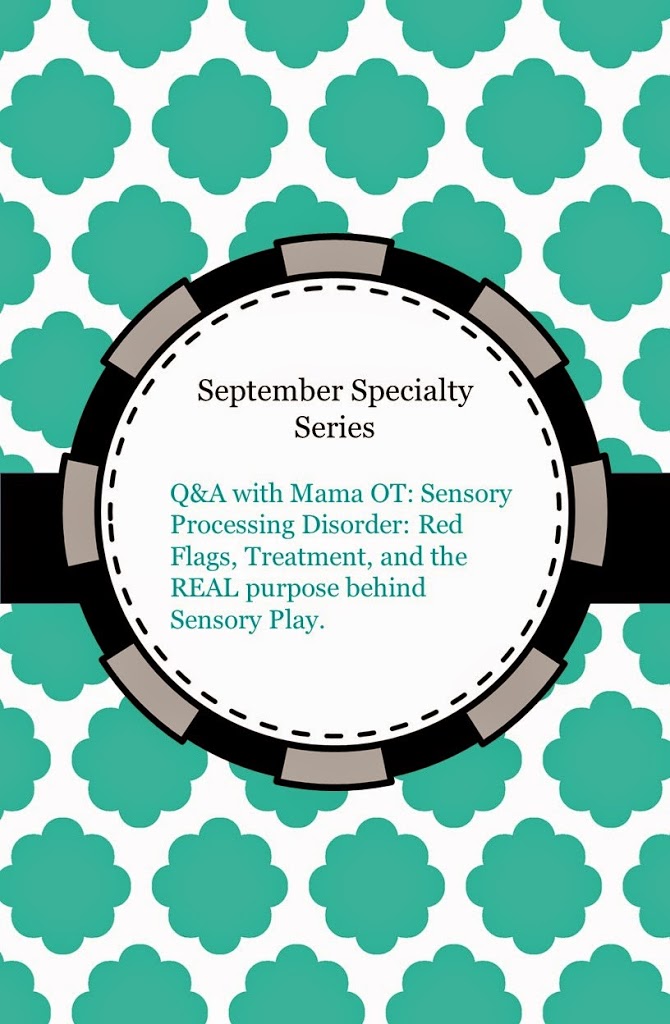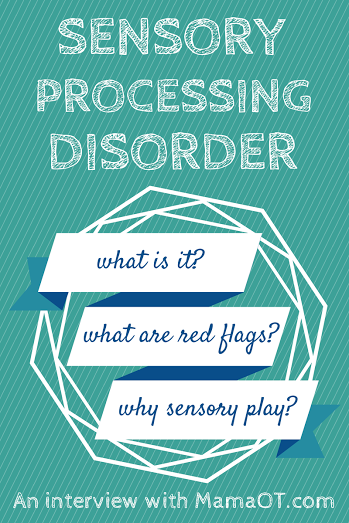September Speciality Series with Mama OT: Sensory Processing DisorderPart II
Today I welcome back Christie from MamaOT for Part II in our Q & A about sensory processing disorder! If you missed Part I, you can read about it here.
Hi Christie! So now that we know WHAT it is, let’s talk about what we can DO about it. My first question is what should parents do if they suspect their child has any warning signs?
If you are a parent and you suspect your child may be demonstrating sensory processing difficulties, mention it to your child’s primary care provider (usually the pediatrician) and be an advocate for your child. It is not uncommon for pediatricians to brush off parental concerns regarding sensory processing difficulties. I have heard many examples from parents where the pediatrician either disregarded the concern altogether (saying something to the effect of, “He’ll grow out it, he’s just active because he’s a boy”, or, “She’ll grow out of it, all toddlers and preschoolers are picky eaters.”), or completely overlooked the sensory issues and labeled them as something else entirely (such as Oppositional Defiance Disorder or ADHD). So, as both a parent and a professional, I strongly feel that parents need to be advocates for their kids. I’m not saying you need to be hostile toward your child’s doctor. But you know your child best. You know how they have been since the day they were born (and before), and you know how significantly their daily life is impacted by their difficulties.
If you do talk to the pediatrician about your concerns, emphasize how these sensory processing difficulties are impacting your child’s ability to perform activities of daily livingsuch as bathing, grooming, dressing, eating, self-feeding, sleeping, or playing. You can also emphasize any safety concerns you have, such as your 4-year-old unsafely seeking movement by climbing onto countertops or fences and then jumping off, or becoming so overstimulated in noisy environments that she begins crashing her body into walls or banging her head. Once you have shared your concerns with the pediatrician, he or she can then put in a referral for an occupational therapy evaluation and, depending on the results, OT treatment sessions can then begin in order to address the areas of concern and goals that are written as part of the evaluation process.
Sensory bins and activities seem to bombard social media, but from a professional perspective, why are they important?
Sensory bins and “messy play” activities allow children to learn and explore through the sense of touch. For children with typically functioning tactile systems, this is good because it provides sensory information to the tactile system that actually helps develop a more refined sense of touch (discrimination) and, subsequently, supports the development of fine motor skills such as using eating utensils, writing implements, scissors, and handheld sports equipment such as a basketball, baseball bat, or tennis racquet. For kiddos who demonstrate any of the three previously mentioned patterns of disordered sensory processing, sensory bins and activities are even MORE important and helpful. For those with over-responsive tactile sensory systems, sensory bins and messy play activities give kids the chance to explore tactile materials in a gradual, non-threatening, fun way. This can help them become more comfortable engaging with textures and substances their body perceives as threatening and can even help decrease picky eating. For kids with under-responsive tactile systems, sensory bins and activities provide the additional sensory input needed to sort of “wake up” their tactile system and give it the extra input it has been missing, which is so important for the development of those fine motor skills. And kids who seek/crave tactile input? They have more fun than anyone! For these kiddos – the touchers, the fidgeters, the grabbers – sensory bins and messy play activities are like a breath of fresh air to their tactile system! It gives them a chance to stimulate that sensory system in a fun, creative, safe, and age-appropriate way. Learn tons of fun ideas for sensory bins, plus find out lots of different ways to play with sensory bins HERE.
What are some easy ways to incorporate sensory activities in the home?
First of all, don’t go crazy trying to do every creative and crazy sensory activity you find on the internet! There are many ways to incorporate and embed sensory activities into your child’s daily routine. Here are a few ideas:
If you have a baby or toddler, let them get messy when they eat. Read more about why this is good HERE.
Allow kids to eat with their hands (when appropriate) so they can be exposed to a variety of textures during meal time.
Give your kids the chance to help with meal preparation and “play” with their food at the end of their meal. Your Kids Table has a great post HERE about why and how to do this.
Use a water table to promote outdoor sensory play and exploration. Learn more about how to use a water table for sensory play HERE.
Many household chores provide natural opportunities for movement and “heavy work”, which is great for all kids but especially those who seek out proprioceptive input (to the joints and muscles). Some examples include taking out the trash, sweeping, mopping, vacuuming, raking leaves, loading or emptying the dishwasher, loading the washing machine with wet clothes, washing mirrors or windows, or mowing the lawn. So if it’s chores time, give your sensory seeker the choice of “heavy work” chores that are appropriate for their age and level of responsibility.
Let your child push the shopping cart at the grocery store.
Start a habit of taking your child (or the whole family) on a walk after dinner. It can be a walk to the park, around the block, or down a favorite path. Your kiddo can push their sibling’s stroller, pull a wagon, or even ride their trike or bike.
Challenge your child to “animal walk” to different parts of the house during their routine activities, such as getting dressed in the morning or getting ready for bed at night. Some good animal walks include walking like a bear (hands and feet on floor, booty in the air), walking like a crab (hands and feet on floor, belly up to the ceiling, booty up off the floor), and crawling like a snake or lizard (belly crawling with arms and legs pulling the body along).
Surviving and navigating Sensory Processing Disorder is no small task. It can be frustrating, confusing, and downright maddening. But remember that there is a community of occupational therapists who are trained to help, intervene, listen, and celebrate successes with you and your child as they work to develop the skills needed to more fully participate in and enjoy life!
Thanks so much Christie! Tell us a little about your blog, MamaOT.com.
MamaOT.com is a place where I share tips and tricks for those who care for children, particularly babies, toddlers, and school-age kids. I started Mama OT in 2012 and love that I am able to use my experience as both a mom and an OT to help other parents, caregivers, therapists, and teachers as they support the development of the children in their lives.
There are many ways you can follow and connect with me!
Blog: http://MamaOT.com
Facebook: http://Facebook.com/MamaOTblog
Pinterest: http://Pinterest.com/ckiley

